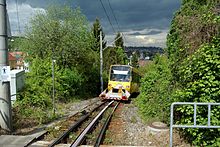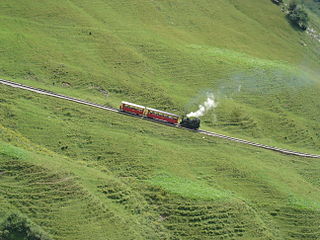This is a list of rack railways, both operating and closed.
This is a list of rack railways, both operating and closed.



Both railways used the Riggenbach system.



A mountain railway is a railway that operates in a mountainous region. It may operate through the mountains by following mountain valleys and tunneling beneath mountain passes, or it may climb a mountain to provide transport to and from the summit.

A rack railway is a steep grade railway with a toothed rack rail, usually between the running rails. The trains are fitted with one or more cog wheels or pinions that mesh with this rack rail. This allows the trains to operate on steep grades above 10%, which is the maximum for friction-based rail. Most rack railways are mountain railways, although a few are transit railways or tramways built to overcome a steep gradient in an urban environment.

Ferrocarrils de la Generalitat de Catalunya, or FGC, is a railway company which operates several unconnected lines in Catalonia, Spain.

The Swiss rail network is noteworthy for its density, its coordination between services, its integration with other modes of transport, timeliness and a thriving domestic and trans-Alp freight system. This is made necessary by strong regulations on truck transport, and is enabled by properly coordinated intermodal logistics.

The Brienz Rothorn Railway is a tourist rack railway in Switzerland, which climbs from Brienz, at the eastern end of Lake Brienz, to the summit of the Brienzer Rothorn. The railway is 7.6 kilometres (4.7 mi) long, is built to 800 mm gauge, and uses the Abt double lamella rack system. Unusually for Switzerland, the line is not electrified, and most trains are operated by steam locomotives.

The Fell system was the first third-rail system for railways that were too steep to be worked by adhesion on the two running rails alone. It used a raised centre rail between the two running rails to provide extra traction and braking, or braking alone. Trains were propelled by wheels horizontally applied and retracted by springs onto the centre rail, controlled from the cab, as well as by the normal running wheels. In practice, the running wheels could be allowed to run freely to reduce wear, but the centre brake shoes needed to be replaced frequently. For example: the locomotives' shoes were replaced after each journey on the Mont Cenis Pass Railway. Extra brake shoes were fitted to specially designed or adapted Fell locomotives and brake vans, and for traction the prototype locomotive had an auxiliary engine powering the horizontal wheels. The Fell system was developed in the 1860s and was soon superseded by various types of rack railway for new lines, but some Fell systems remained in use into the 1960s. The Snaefell Mountain Railway still uses the Fell system for (emergency) braking, but not for traction.

The Montserrat Rack Railway is a mountain railway line north-west of Barcelona in Catalonia. The line runs from Monistrol de Montserrat to the mountain-top monastery of Montserrat.

The Montenvers Railway or Chemin de fer du Montenvers is a rack railway line in the Haute-Savoie department of France. The line runs from a connection with the SNCF, in Chamonix, to the Hotel de Montenvers station, at the Mer de Glace, at an altitude of 1,913 m (6,276 ft).

Rigi Railways is a railway company that operates a group of railways on the mountain Rigi, located between two of the arms of Lake Lucerne, in Switzerland. They include two standard gauge rack railways, the Vitznau–Rigi Bahn (VRB) and the Arth–Rigi Bahn (ARB), along with the Luftseilbahn Weggis–Rigi Kaltbad (LWRK) cable car.

The Diakopto–Kalavryta railway is a historic 750 mm gauge rack railway in Greece. Located on the northern Peloponnese, it runs 22 kilometres (14 mi) from Diakopto through the Vouraikos Gorge and the old Mega Spilaion Monastery and up to Kalavryta, stopping en route at Zachlorou. Today, the infrastructure and rolling stock are owned and maintained by the Hellenic Railways Organisation (OSE) and passenger trains are operated by Hellenic Train. At the Diakopto terminus, the line connects with the new standard-gauge Athens Airport–Patras railway; as of 2019 the new track is in place in a cutting through the station yard.

The Montreux–Glion–Rochers-de-Naye railway line is an electrically operated rack railway in Switzerland with a track gauge of 800 mm. The line connects the resort of Montreux, on the shores of Lake Geneva, with the summit of the Rochers de Naye mountain. The line operates via the village of Glion, on the mountainside above Montreux, where it connects with the Territet–Glion funicular.

The Aigle–Leysin railway line is a narrow-gauge railway line in the Chablais area of southwest Switzerland. The line was opened on 5 May 1900, a 1,000 mm -gauge cog-wheel railway using the Abt rack system. It was the first such line in the region. The line was built by the Chemin de fer Aigle–Leysin.

The Chemins de fer électriques Veveysans (CEV) was a railway company that built and operated narrow gauge electric railway lines from Vevey to Blonay, Chamby, Châtel-St-Denis and Les Pléiades, in Switzerland. It began operations in 1902. The CEV and three other companies merged to become the Transports Montreux–Vevey–Riviera in 2001. The Vevey–Les Pléiades railway line remains in active use.

The Ambarawa Railway Museum is a museum located in Ambarawa in Central Java, Indonesia. The museum preserves around 21 steam locomotives and focuses on tourism train tours hauled by 3 operational steam engines and a hydraulic diesel engine, using the remains of the closing of the 3 ft 6 in (1,067 mm) railway line.

Most narrow-gauge railways in Italy were built with Italian metre gauge, which is actually 950 mm because historically the Italian track gauge was defined from the centres of the rail instead of the internationally accepted method of measuring the gauge from the inside edges of the rails. Several metre-gauge lines were built in northern Italy.

800 mm gauge railways are narrow-gauge railways built to a track gauge of 800 mm.